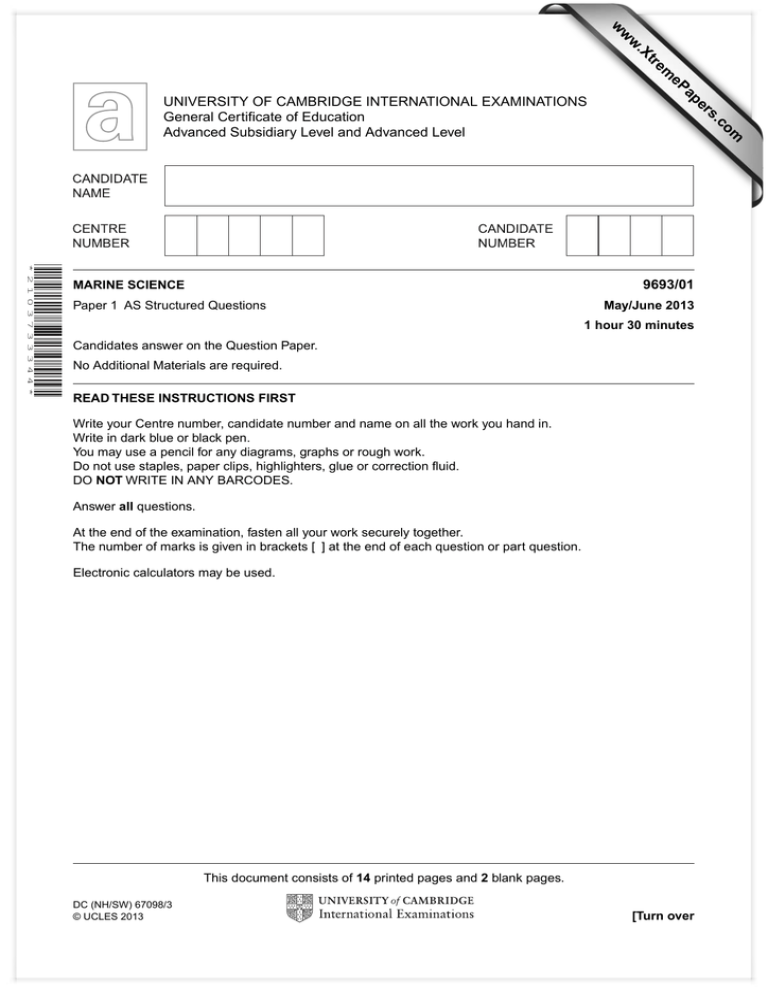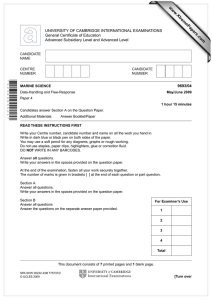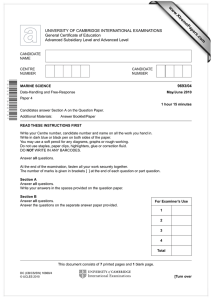www.XtremePapers.com
advertisement

w w ap eP m e tr .X w om .c s er UNIVERSITY OF CAMBRIDGE INTERNATIONAL EXAMINATIONS General Certificate of Education Advanced Subsidiary Level and Advanced Level * 2 1 0 3 7 3 3 3 4 4 * 9693/01 MARINE SCIENCE Paper 1 AS Structured Questions May/June 2013 1 hour 30 minutes Candidates answer on the Question Paper. No Additional Materials are required. READ THESE INSTRUCTIONS FIRST Write your Centre number, candidate number and name on all the work you hand in. Write in dark blue or black pen. You may use a pencil for any diagrams, graphs or rough work. Do not use staples, paper clips, highlighters, glue or correction fluid. DO NOT WRITE IN ANY BARCODES. Answer all questions. At the end of the examination, fasten all your work securely together. The number of marks is given in brackets [ ] at the end of each question or part question. Electronic calculators may be used. This document consists of 14 printed pages and 2 blank pages. DC (NH/SW) 67098/3 © UCLES 2013 [Turn over 2 1 (a) Explain what is meant by each of the following terms used in ecology. (i) habitat ....................................................................................................................... .............................................................................................................................. [1] (ii) community ................................................................................................................. .................................................................................................................................. .................................................................................................................................. .............................................................................................................................. [2] (b) Table 1.1 shows the range of particle sizes found on two different types of shore. Table 1.1 (i) type of shore particle diameter / mm sandy 0.02 to 2.0 muddy 0.002 to 0.2 Compare the particle sizes of the sandy shore and the muddy shore. .................................................................................................................................. .................................................................................................................................. .................................................................................................................................. .................................................................................................................................. .................................................................................................................................. .............................................................................................................................. [3] (ii) Explain how the process of sedimentation gives rise to a muddy shore. .................................................................................................................................. .................................................................................................................................. .................................................................................................................................. .................................................................................................................................. .................................................................................................................................. .............................................................................................................................. [3] © UCLES 2013 9693/01/M/J/13 For Examiner’s Use 3 (iii) Using the information in Table 1.1 and your own knowledge, explain why a rocky shore tends to have a higher biodiversity than a sandy shore. For Examiner’s Use .................................................................................................................................. .................................................................................................................................. .................................................................................................................................. .................................................................................................................................. .................................................................................................................................. .............................................................................................................................. [4] [Total: 13] © UCLES 2013 9693/01/M/J/13 [Turn over 4 2 (a) Fig. 2.1 shows the oxygen concentration at different temperatures in fresh water. For Examiner’s Use 16 14 12 oxygen concentration / mg per dm3 10 8 6 4 2 0 0 5 10 15 20 25 30 temperature / °C 35 40 45 Fig. 2.1 (i) State the change in oxygen concentration between 5 °C and 15 °C. .............................................................................................................................. [2] (ii) Use Fig. 2.1 to estimate the oxygen concentration at a temperature of 45 °C. .............................................................................................................................. [1] (iii) Table 2.1 shows the oxygen concentration in sea water at different temperatures. Table 2.1 temperature / °C oxygen concentration / mg per dm3 0 5 10 15 20 25 30 35 11.4 10.0 8.6 8.0 7.4 6.4 6.0 5.4 Plot these data on Fig. 2.1. © UCLES 2013 [4] 9693/01/M/J/13 5 (iv) Describe the differences between the oxygen concentrations in fresh water and in sea water. For Examiner’s Use .................................................................................................................................. .................................................................................................................................. .................................................................................................................................. .................................................................................................................................. .................................................................................................................................. .............................................................................................................................. [3] © UCLES 2013 9693/01/M/J/13 [Turn over 6 (b) Fig. 2.2 shows the oxygen concentration at different depths in sea water. For Examiner’s Use 0 100 200 300 400 depth / metres 500 600 700 800 900 1000 oxygen concentration Fig. 2.2 Explain the relationship between oxygen concentration and depth as shown in Fig. 2.2. .......................................................................................................................................... .......................................................................................................................................... .......................................................................................................................................... .......................................................................................................................................... .......................................................................................................................................... .......................................................................................................................................... .......................................................................................................................................... .......................................................................................................................................... .......................................................................................................................................... ...................................................................................................................................... [5] [Total: 15] © UCLES 2013 9693/01/M/J/13 7 BLANK PAGE Turn over for question 3. © UCLES 2013 9693/01/M/J/13 [Turn over 8 3 Fig. 3.1 shows part of a food web in a kelp forest. killer whales For Examiner’s Use sheepshead sea otters lobsters abalones cod sea urchins kelp Fig. 3.1 (a) With reference to Fig. 3.1, explain what is meant by a producer. .......................................................................................................................................... .......................................................................................................................................... .......................................................................................................................................... .......................................................................................................................................... .......................................................................................................................................... .......................................................................................................................................... .......................................................................................................................................... ...................................................................................................................................... [4] (b) With reference to Fig. 3.1, explain what is meant by a predator-prey relationship. .......................................................................................................................................... .......................................................................................................................................... .......................................................................................................................................... .......................................................................................................................................... .......................................................................................................................................... ...................................................................................................................................... [3] © UCLES 2013 9693/01/M/J/13 9 (c) Commercial fishing in this area targets cod and sheepshead. Using the information in Fig. 3.1, suggest and explain one possible effect of commercial fishing on the population of sea otters. For Examiner’s Use .......................................................................................................................................... .......................................................................................................................................... .......................................................................................................................................... .......................................................................................................................................... .......................................................................................................................................... .......................................................................................................................................... .......................................................................................................................................... .......................................................................................................................................... ...................................................................................................................................... [4] [Total: 11] © UCLES 2013 9693/01/M/J/13 [Turn over 10 4 (a) Describe three pieces of evidence supporting the theory of plate tectonics. 1 ....................................................................................................................................... .......................................................................................................................................... .......................................................................................................................................... .......................................................................................................................................... 2 ....................................................................................................................................... .......................................................................................................................................... .......................................................................................................................................... .......................................................................................................................................... 3 ....................................................................................................................................... .......................................................................................................................................... .......................................................................................................................................... ...................................................................................................................................... [6] (b) Fig. 4.1 shows one type of tectonic plate boundary. Fig. 4.1 With reference to Fig. 4.1, explain how movements at a plate tectonic boundary can lead to the formation of an ocean trench. .......................................................................................................................................... .......................................................................................................................................... .......................................................................................................................................... .......................................................................................................................................... .......................................................................................................................................... ...................................................................................................................................... [3] © UCLES 2013 9693/01/M/J/13 For Examiner’s Use 11 (c) Explain how movements at a plate tectonic boundary can lead to the formation of a tsunami. For Examiner’s Use .......................................................................................................................................... .......................................................................................................................................... .......................................................................................................................................... .......................................................................................................................................... .......................................................................................................................................... .......................................................................................................................................... .......................................................................................................................................... ...................................................................................................................................... [4] [Total: 13] © UCLES 2013 9693/01/M/J/13 [Turn over 12 5 (a) (i) Explain what is meant by the term productivity, in marine ecosystems. .................................................................................................................................. .................................................................................................................................. .................................................................................................................................. .................................................................................................................................. .................................................................................................................................. .............................................................................................................................. [3] (ii) List three factors which affect productivity. 1 ................................................................................................................................ .................................................................................................................................. 2 ................................................................................................................................ .................................................................................................................................. 3 ................................................................................................................................ .............................................................................................................................. [3] (b) Fig. 5.1 shows variations in productivity with depth in the Northeast Pacific Ocean in winter, spring and summer. 0 0 10 20 30 40 winter 10 summer 20 spring depth / m 30 40 50 60 0 10 20 30 40 3 productivity / mg of fixed carbon per m per day Fig. 5.1 © UCLES 2013 9693/01/M/J/13 For Examiner’s Use 13 (i) State the depth at which the difference in productivity between winter and spring is greatest. For Examiner’s Use .............................................................................................................................. [1] (ii) Suggest explanations for the differences between the productivity in the Northeast Pacific Ocean in the winter and the spring. .................................................................................................................................. .................................................................................................................................. .................................................................................................................................. .................................................................................................................................. .................................................................................................................................. .................................................................................................................................. .................................................................................................................................. .............................................................................................................................. [4] [Total: 11] © UCLES 2013 9693/01/M/J/13 [Turn over 14 6 (a) Runoff is important in replenishing the reservoir of dissolved nutrients in the sea. (i) Describe what is meant by the term runoff. .................................................................................................................................. .................................................................................................................................. .................................................................................................................................. .................................................................................................................................. .................................................................................................................................. .............................................................................................................................. [3] (ii) Suggest how runoff can be harmful to marine organisms. .................................................................................................................................. .................................................................................................................................. .................................................................................................................................. .................................................................................................................................. .................................................................................................................................. .............................................................................................................................. [3] (iii) Suggest how runoff can be beneficial to marine organisms. .................................................................................................................................. .................................................................................................................................. .................................................................................................................................. .............................................................................................................................. [2] © UCLES 2013 9693/01/M/J/13 For Examiner’s Use 15 (b) The mean concentration of calcium in sea water is 0.41 parts per thousand. For Examiner’s Use Suggest why this concentration remains approximately constant. .......................................................................................................................................... .......................................................................................................................................... .......................................................................................................................................... .......................................................................................................................................... .......................................................................................................................................... .......................................................................................................................................... .......................................................................................................................................... ...................................................................................................................................... [4] [Total: 12] © UCLES 2013 9693/01/M/J/13 16 BLANK PAGE Permission to reproduce items where third-party owned material protected by copyright is included has been sought and cleared where possible. Every reasonable effort has been made by the publisher (UCLES) to trace copyright holders, but if any items requiring clearance have unwittingly been included, the publisher will be pleased to make amends at the earliest possible opportunity. University of Cambridge International Examinations is part of the Cambridge Assessment Group. Cambridge Assessment is the brand name of University of Cambridge Local Examinations Syndicate (UCLES), which is itself a department of the University of Cambridge. © UCLES 2013 9693/01/M/J/13






